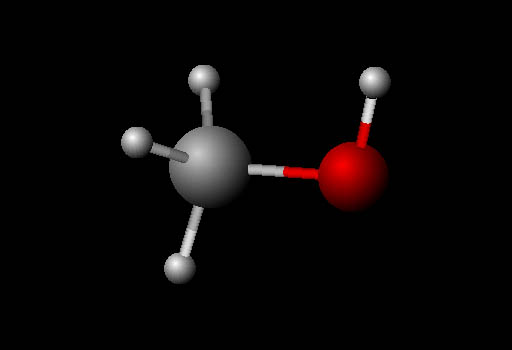Ball and Stick Molecular Models
(with painted grapes)
 |
| Wood Alcohol - Methanol |
 |
| CH3OH |
 |
| Methane |
 |
| CH4 |
 |
| Grain Alcohol - Ethanol |
 |
| C2H5OH |
Common Household Chemicals We Use or Eat:
(IUPAC name -
common name - molecule formula)
1. Ethylene Glycol - Antifreeze - C2H4(OH)2
2. Sodium Hydroxide - Drain Cleaner - NaOH
3.Aluminum Chlorohydrate - Deodorants - Al2Cl(OH)5
4. Acetylsalicylic Acid - Aspirin - C9H8O4
5. Sodium Chloride -Table Salt - NaCl
6. Sucrose - Table Sugar - C12H22O11
7. Acetic acid -Vinegar - HC2H3O2
8. Calcium Carbonate - Tums - CaCO3
9. Sodium Carbonate Decahydrate - Water Softner - NaCO3⋅10H2O
10. Polymer of Tetrafluoroethylene - Teflon - (C2F4)n
| Used to make non-stick surfaces |
11. Calcium Carbonate - Chalk - CaCO3

12. Sulphuric Acid - Battery Acid - H2SO4
13. Sodium Bicarbonate -Baking Powder - NaHCO3
14. Ethanol - Alcohol - C2H6O
15. Graphite (Carbon) - Black Lead - C
16. Ethyl Alcohol - Mouthwash - CH3CH2OH
17. Boric Acid - Antiseptics/Insecticides/Flame retardant Properties - H3BO3
18. Silicon Dioxide - Quartz - SiO2
19. Toluene- Paint Thinner - C7H8 or C6H5CH3
20. Sodium Hypochlorite - Bleach - NaOCl
3. Look over your molecules and the bonding characteristics, how many
bonds does each of the following elements typically have? (Carbon, Hydrogen, and Oxygen)
Carbon typically has four bonds, while Hydrogen typically has one bonds, and oxygen usually has two bonds.
4. What does IUPAC stand for?
IUPAC stands for The International Union of Pure and Applied Chemistry.
5. As you explore ingredients, notice how everything around us is
made up of chemicals consisting of atoms bound together into molecules.
But what about companies that claim their products are chemical free!
How can this be?
Even though a company claims to have a "chemical free" product, their product is still going to have chemicals in them because everything is a chemical at the molecular level. When a company claims to have a "chemical free" product, they are basically using it as a market ploy to get more people to use their product. Instead their product is most likely just made from more natural chemicals instead of chemicals formed in labs, making them safer for the environment.
In This Chemical:
http://www.naturalhealthcareproducts.com/Cleaning-Products.php
Green Aussie is not a chemical free product, but instead a more environmentally friendly cleaning product. It's a water based cleaner with scents from plants such as spearmint. Water is a chemical within it self, formed by oxygen and hydrogen, while the spearmint plant contains chemicals like menthol (about 50%), menthone (between 10% and 30%), and mentyl esters (up to 10%).
thx
ReplyDelete